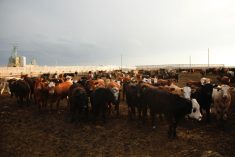Western Canadian feeder cattle prices were $4-$6 higher on average — in some cases as much as $10 higher in the major feeding regions of Alberta. A couple of auction barns held their first yearling sale of the year and optimism returned with a vengeance. A minor bounce in feeder and live cattle futures along with a softer Canadian dollar set a positive tone. Feedlot operators appeared to see the spirit of dollar signs through a magical lens which so often occurs early in the season. Memories of the past year were muffled. These replacements will be sold during peak holiday season demand and buyers were talking as if this was the last chance for a potential 2016 sweepstake.
Read Also

U.S. grains: Wheat futures rise on supply snags in top-exporter Russia
U.S. wheat futures closed higher on Thursday on concerns over the limited availability of supplies for export in Russia, analysts said.
In east-central Alberta, steers weighing between 900 and 950 lbs., averaging 919 lbs., sold for a mean price of $180; at the same sale, 800- to 850-lb. steers moved at an average of $191. Feedlot operators were watching prices south of the border, where 917-lb. steers sold for US$150 in Nebraska, slightly above the feeder cattle futures. This may be a sign that the feeder futures have overextended to the downside, but it will take a couple of weeks for the invisible hand to align market forces. Alberta fed cattle prices were relatively unchanged from last week, but values in the U.S. southern Plains were $1-$3 higher. Wholesale beef prices are holding value and this will be key to sustaining the price structure.
Few calves are coming on the market this time of year. Abundant rains have pastures on steroids and cow-calf producers are awash with feed grains and forage. Barley and feed wheat prices are falling faster than a meteor. Lethbridge barley traded in the low $170s this past week. This may be the year to sell grain on the hoof rather than on wheels or rail.
— Jerry Klassen is manager of the Canadian office for Swiss-based grain trader GAP SA Grains and Produits. He is also president and founder of Resilient Capital, which specializes in proprietary commodity futures trading and commodity market analysis. Jerry owns farmland in Manitoba and Saskatchewan but grew up on a mixed farm/feedlot operation in southern Alberta, which keeps him close to the grassroots level of grain and cattle production. Jerry is a graduate of the University of Alberta. He can be reached at 204-504-8339.



















